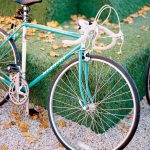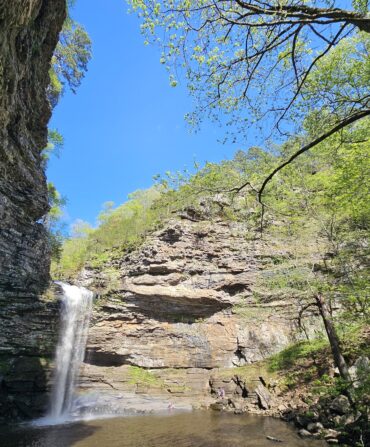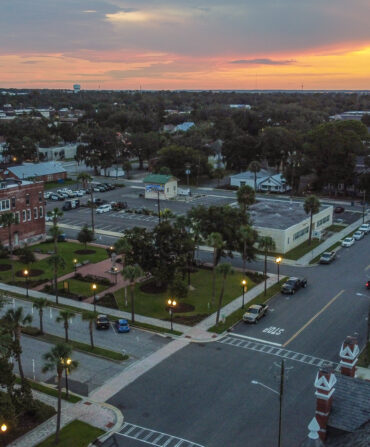I followed the ribbon of dirt downslope, descending quick and easy, before slowing my mountain bike to navigate a series of perfectly cambered 180-degree turns. Five miles of single-track trails crisscross Louisville, Kentucky’s Cherokee Park. They snake up from Beargrass Creek, drop down sets of stone steps, and meander across clearings. As I pedaled into the woods, a carpet of leaves reflected light upward, infusing stands of oak and sycamore. I paused to consider that I was riding not in a state wildlife refuge but in the middle of a large, bustling city.
You know Louisville for Churchill Downs and for the amber promise of bourbon that goes down hot and sweet. But it’s also emerging as one of America’s best cycling cities. The latest evidence? The Big Four Pedestrian & Bicycle Bridge, an $18 million car-free span across the Ohio River. Already partially open, the soaring, rust-colored lattice of riveted beams—built from a former railroad line—will be completed this October. “There’s a big fellowship aspect to all this,” says Mayor Greg Fischer. Twice a year, on Memorial Day and Labor Day, the city closes streets for an event called Hike, Bike & Paddle; the last drew 12,000 cyclists. And though lots of cities have cycling clubs, few manage to organize sixty-five centuries—cyclist slang for hundred-mile routes—every year, as the Louisville Bicycle Club does. The group hosts smaller rides almost every day, from slow cruises for beginners to speed workouts designed for die-hard roadies. “It’s a cyclist’s dream,” says Brad Swope, a sixty-three-year-old competitive rider who was born and raised in Louisville.
Here, anyone who takes to the street on two wheels taps into local heritage too. In 1896, when cycling mania first swept the world, Louisville boasted more bikes per capita than any other city in the United States. In winter months, enterprising brewery owners built velodromes inside dance halls. In fair weather, thousands of spectators crowded the streets to watch men’s and women’s road races. The latter thrilled as much for spectacle—female racers sported scandalously skimpy bloomers—as for sport.
On a sunny Friday I met Louisville Bicycle Club president Andy Murphy at Quills Coffee, an airy spot on Baxter Avenue with a stamped tin ceiling and fantastic house-roasted brew. A gray-haired retired assembly line worker for Ford Motor Company, Murphy arrived carrying a high-end messenger bag and sprinkling the word “dude” into most sentences. Like Louisville itself, he’s half Rust Belt, half modern.
We rode east to see an outdoor version of the old velodromes: Eva Bandman Park. Here aficionados of cyclo-cross take laps on courses spiked with staircases, bridges, and other barricades. The obstacles force riders to dismount, toss the bike over a shoulder, and run. This past February the park hosted the cyclo-cross world championships, marking the first time the sixty-year-old event has been held outside Europe.
We U-turned and drifted west, past the Belle of Louisville steamboat and into the working-class neighborhoods of Portland and Shawnee. This side of town has a reputation for crime, but the faded Craftsman houses and near-empty streets seemed more sleepy than dodgy, and Murphy leads a group of cyclists through the area every week. We traveled from Shawnee to the office buildings and storefronts of downtown. Then we detoured to Old Louisville, taking the bike lanes on Third Street to a neighborhood dense with bronze fountains and nineteenth-century Victorians. But with more than twenty miles behind us, I needed lunch.
Not a problem. We rode to the emerging Butchertown neighborhood and stopped at the Blind Pig. Located in a circa-1870 building, the three-year-old restaurant is a temple to house-made sausages, such as boudin blanc and chorizo, and house-cured meats. So instead of bananas or energy drinks, my ride ended with more soulful recovery food: a salty-crisp BLT.
By Sunday, I’d experienced an urban ride with Murphy, the calm of Cherokee Park, and more great food at Harvest, which serves comfort fare like fried chicken and hoecakes alongside a smart selection of bourbon cocktails and flights. But I’d yet to complete a true road ride. Which is why I found myself outside Vic’s Classic Bikes at 9:00 a.m. for a weekly group ride that locals say only gets canceled if it snows.
Bike shops ring Cherokee Park, and Vic’s specializes in lugged steel bicycles from the seventies and eighties. The owner, Victor Miller, scours the Internet and estate sales for vintage Cinellis, Fujis, and first-generation Treks. “That’s artisan work there,” he’d said in reference to the pinstriping on an English bike made by the Jack Taylor workshop. “The only way to do that is by hand.”
More than twenty-five riders strong, our group went up hills to the south before circling back to the flats of River Road. A tandem pulled to the front and raised the pace. I was focusing, barely keeping up, when I lifted my head to see the view before me: downtown, with its silvery skyscrapers flashing in the sun, the Ohio River stretched wide and deep to my right, a few whitecaps disturbing the surface. I drew the sight inside me like a breath of air, then put my head down and pedaled harder.










